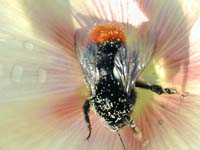
To granulate liquid honey just leave it. If its mine, it will
re-granulate quite quickly - days or months. Commercial liquid honey will be
much slower, as they prepare it carefully.
Nikola and I both sell honey - I'm not sure about Jo. £2.50 / lb (OK, OK
per 454 g - trading standards insist its per g, and in those funny units. But 454g *is* 1 lb. Nearly). Orders may be placed by email or phone...
see
here for my contact details. Delivery has to be
by hand, which I'm happy to do within the village, but outsiders would have to collect...
Honey sold is in new jars, guaranteed to be clean, safe and wholesome to eat...
but not necessarily 100% free of "bits"... you may find the odd small flake of wax in there, perfectly safe to eat. I'm happy to take orders for quantities from individual jars upwards. Bulk orders get a discount!
Bees and Honey in Coton
I know of three beekeepers. And they are:
Honeybees, Bumblebees, Wasps. Etc.
Its hard to see, because I provided no scale, but the bumblebee is bigger. Also its fatter, hairier, and tends to have one (or two) bands of brightish yellow, orange or red. Bumblebees are either solitary, or come in nests of 10-50 ish bees.
Wasps, as we all know, are wasp-waisted; bright yellow-and-black banded;
sharply pointed at the tail; and not at all beloved of beekeepers. They
tend to be somewhat more aggressive than bees. Wasps too have their
good side: they eat various bugs. But if you have a wasps nest you need
to remove, contact the District Council, they have special people to do this.
Swarms of bees
A swarm of bees is a *lot* of bees. Not 1, not 10, not even 100. Once you've
got to about 1000 (ie, more than you could count) then you have a swarm.
A swarm likes to go into an analogue of its natural habitat - a hollowed-out tree. Ie, a dark enclosed box. My picture shows the most bizarre place I've seen, a swarm in a gas meter enclosure.
Typically, swarms occur in May. The swarm is the hive reproducing itself; about half the bees and the old queen leave to swarm. So a good swarm will be 5,000-20,000 bees. If the air is black with bees, its a swarm. A swarm will usually settle on a tree branch or bush, lost bees will join it, and it coalesces to a rugby-ball shaped and sized object, depending on bee number and surrounding geometry. It is waiting, sending out bees to spy out a good permanent home.
If you have a swarm, don't worry. Bees are at their most docile when swarming (or so everyone says). Simply contact one of your local village beekeepers, or the CBKA, or the District Council (who keep a list of beekeepers, and will give you the name of someone willing to collect a swarm if you phone them). But its best to contact one of us first, if you can.
You *can* just wait and see if the swarm goes away. But its best not to, because it will just go annoy someone else. Or, it may decide to go live in your brickwork, if you have nice old brickwork with lots of gaps. This happened at the crematorium.
The CBKA also provides some swarm info: http://www.cwucb.org/CBKA/lotsofbits.htm
Email: wmc@bas.ac.uk | Web: www.wmconnolley.org.uk | Page proudly created with vi(m).